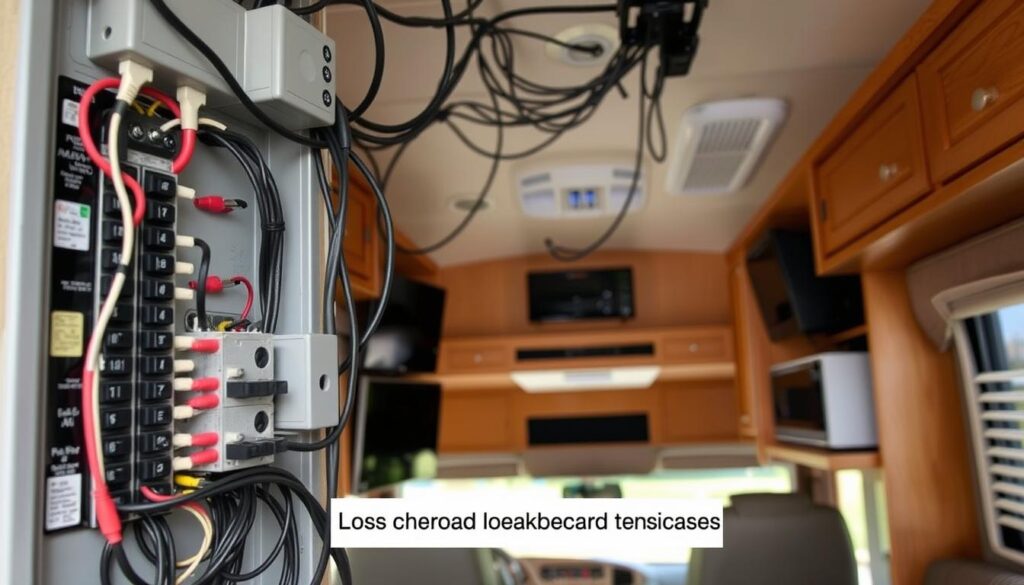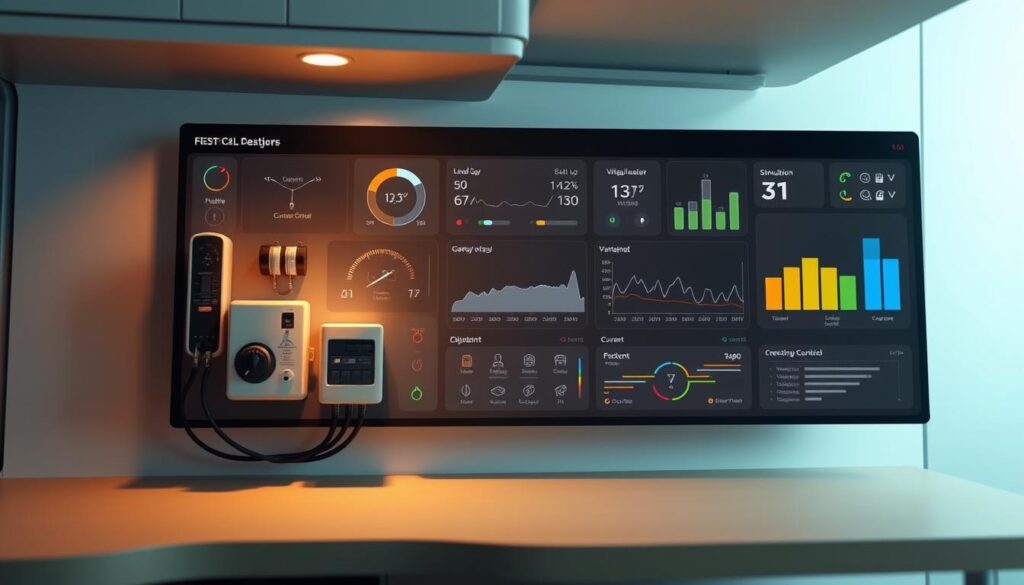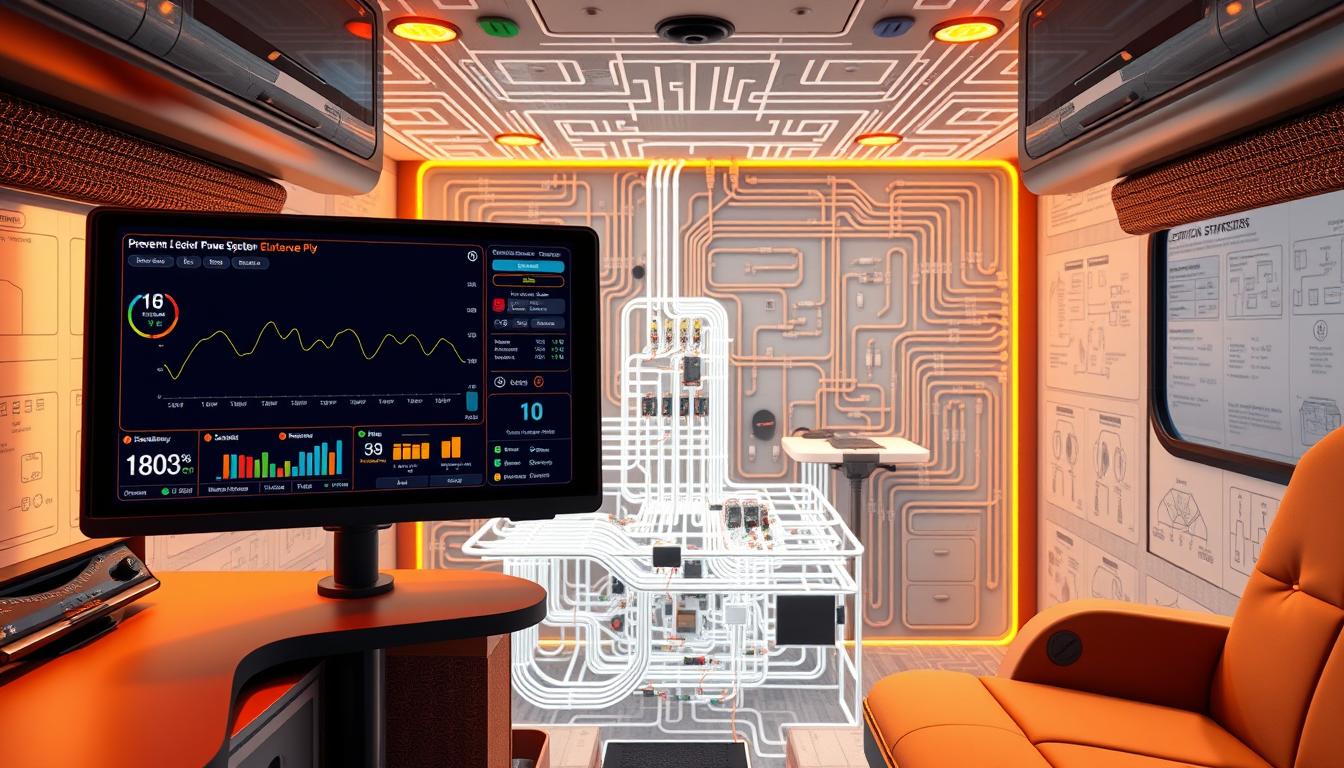Ever thought about how a small electrical issue could ruin your Class C motorhome adventures? With today’s complex electrical systems, preventing power overloads is more important than ever. Using advanced simulation tools, you can manage your RV’s electrical loads better. This ensures your travels are safe and reliable.
This article will explore how simulation tools for RVs can stop overloads. They help keep your trips smooth and worry-free.
Introduction to Electrical Systems in Class C Motorhomes
Class C motorhome electrical systems are vital for comfort and function on the road. They power everything from lights to kitchen appliances. Key parts include batteries, converters, and inverters. Knowing how they work is crucial for managing power well.
RV electrical systems differ by model. Battery size, converter types, and inverter designs affect performance. Choosing a motorhome should consider your power needs for a better experience.
The Importance of Preventing Overloads
Keeping electrical systems safe in motorhomes is key. Overloads can damage not just appliances but the whole electrical system. When demand is too high, it can lead to overheating and dangers.
Class C motorhome owners need to watch out for overload risks. Ignoring them can cause appliances to fail, ruining travel comfort. Worse, it can start fires, putting lives and property at risk. Managing loads well keeps everyone safe.
To avoid electrical failures, check how much energy you need versus what’s available. Knowing circuit limits helps spread power better. This way, motorhome owners can travel safely, without worrying about electrical problems.
Understanding Electrical Load in Motorhomes
Managing the electrical load is key for motorhome owners. It’s about knowing how much power you need and how it changes with use. Doing a detailed load calculation helps your electrical system work well without overloading.
Several things affect how much power you need. This includes the power of your appliances and how many you use at once. For example, using a microwave with other high-power devices can really up your power use. So, it’s crucial to calculate your load correctly to not go over your motorhome’s electrical limit.
Getting to know your electrical load helps you pick the right parts. It also keeps you safe and your system running long. Checking your power needs often makes traveling more fun and stress-free.
Common Causes of Electrical Overloads in Class C Motorhomes
Electrical overloads are a big risk for Class C motorhome owners. Knowing what causes them can help keep your RV safe and running well. Using many high-wattage appliances at once is a common problem. This includes things like microwaves, air conditioners, and hair dryers.
When these devices use power together, they can overload the system. This can lead to failures or even safety hazards.
Another big issue is faulty wiring in the motorhome. Worn or damaged wires can cause resistance, which increases heat. This can lead to overload situations. It’s important to check and maintain electrical connections regularly.
Also, using the wrong circuit breakers can cause problems. Breakers are meant to trip when a circuit gets too hot. But if they’re not rated right, they might not protect well. Using the right circuit breakers is key to avoiding electrical risks.

Knowing about these common causes helps motorhome owners take better care of their electrical systems. By being proactive, you can make your travels safer and more reliable.
Tools to Simulate Electrical Load in Class C Motorhome
Managing electrical systems in Class C motorhomes is key. Simulation tools for RVs help a lot. They give insights into electrical system performance and stability. This ensures the systems work well without overloading.
Overview of Simulation Tools
Many tools are out there for RV electrical load simulation. You can find software like ETAP, MATLAB/Simulink, and SKM PowerTools. Each tool has special features for analyzing voltage, current, and power. They help predict overloads and guide adjustments.
Benefits of Using Simulation Tools
Using simulation tools has many benefits. Here are some:
- Enhanced System Reliability: They help design systems that can handle loads over time.
- Improved Safety: Predictive analysis reduces risks of fires and equipment failures.
- Informed Decision-Making: Detailed analysis leads to better power management.
| Simulation Tool | Main Features | Notable Benefits |
|---|---|---|
| ETAP | Comprehensive load flow and short circuit analysis | High accuracy in predictions |
| MATLAB/Simulink | Dynamic simulations for different scenarios | Versatile modeling capabilities |
| SKM PowerTools | Easy-to-use interface for load analysis | Time-efficient for quick evaluations |
How Simulation Tools Work
Operational simulation tools are key in modeling the electrical load for Class C motorhomes. They need specific data to accurately predict how the electrical system works under different conditions. This data includes appliance ratings, system voltages, and how often they are used.
Once the data is entered, the software uses algorithms and models to check for overload scenarios. This helps users see how their systems handle different loads.
The technology behind these tools does complex calculations. It estimates current draw, voltage drops, and system capacity. By trying out different setups and usage patterns, users can see how their systems perform. This helps them make better choices about their electrical setup.
This approach helps find weaknesses in the electrical system before they cause overloads. It makes the system safer and more efficient. Knowing how these tools work is very helpful for improving electrical performance in Class C motorhomes.
Types of Simulation Tools for Electrical Systems
Simulation tools are key for improving electrical systems in Class C motorhomes. They include voltage and current simulation software, and load flow analysis tools. Knowing how they work can make a motorhome’s electrical system more efficient and safe.
Voltage and Current Simulation Software
Voltage simulation tools predict voltage changes in electrical circuits. They help users see how the system acts under different conditions. This ensures electrical parts can handle the needed loads.
Current simulation software looks at electric current flow. It helps spot issues where too much current might cause overloads. These tools together offer deep insights into electrical system design and operation.
Load Flow Analysis Tools
Load flow analysis is vital for understanding power distribution in a motorhome’s electrical system. These tools check how well the system works under various loads. They make sure all parts get enough power.
Using these tools, motorhome owners can decide on upgrades or changes. This improves system reliability. Combining voltage and current simulation with load flow analysis gives a full view of electrical system management.
| Tool Type | Main Functionality | Key Benefits |
|---|---|---|
| Voltage Simulation Tools | Models voltage behavior in circuits | Predicts electrical performance |
| Current Simulation Software | Analyzes current flow and distribution | Identifies potential overload risks |
| Load Flow Analysis Tools | Evaluates power distribution | Ensures adequate supply and reliability |
Features to Look for in Simulation Tools
When picking simulation tools, look for the best features. A user-friendly interface makes it easier to learn and use. This helps both motorhome owners and technicians.
Accuracy in simulations is key. Tools that give precise data help users make reliable decisions. Also, make sure the tool works well with your motorhome’s systems. This saves time and effort.
Real-time analysis is another important feature. Tools that analyze data as it happens help users make quick decisions. By focusing on these features, you can find the right electrical simulation software for you.

Step-by-Step Guide to Using Simulation Tools
Simulation tools can greatly improve your Class C motorhome’s electrical system. They help ensure your system works well and safely. This guide will show you how to use these tools effectively, helping you manage your electrical load better.
Setting Up Your Motorhome’s Specifications
First, collect all important RV electrical system specs. This includes battery size, inverter power, appliance wattage, and model-specific needs. Put these details into the simulation tool for a solid starting point.
Running Simulations for Load Analysis
Once you’ve entered the specs, start the simulation to check the electrical load. The tool will run tests based on your input, showing how appliances affect energy use. Look over the results carefully to spot any overload risks. Then, adjust your appliance use to keep everything balanced.
Interpreting Simulation Results
Understanding simulation results is key for managing electrical systems in Class C motorhomes. By analyzing data, we can spot electrical problems early. Each tool gives specific results that need careful review.
For example, checking voltage stability is crucial. It must match the expected load demands to keep the system safe.
When looking at RV simulation results, two things are important: load distribution and peak load times. Knowing how energy use changes helps us avoid overloading circuits. Also, watching simulations in real-time helps us tell normal spikes from dangerous overloads.
- Load Distribution Analysis: Checking how loads are spread helps improve performance.
- Peak Load Timing: Knowing when the highest demand happens helps us plan better.
Also, getting insights from simulation results helps us make smart choices. A well-managed electrical system is safer and more efficient. Using simulation data for planning helps avoid electrical failures.
| Simulation Parameters | Expected Range | Actual Value | Status |
|---|---|---|---|
| Voltage Level | 120V – 130V | 125V | Within Range |
| Current Load | 0 – 30A | 28A | Within Range |
| Power Factor | 0.8 – 1.0 | 0.85 | Within Range |
| Frequency | 58Hz – 62Hz | 60Hz | Within Range |
Mitigating Risks of Overloads with Proper Planning
Effective planning for load management is key for safety and performance in Class C motorhomes. Strategies for risk mitigation in RV electrical systems can stop electrical overloads. This makes your trip smooth and stress-free.
Load-balancing is a crucial strategy. Knowing how much current each appliance needs helps spread the electrical load well. This lowers the chance of overloading circuits and extends the life of electrical parts.
Choosing quality components is also vital for electrical safety. Good wiring, circuit breakers, and inverters can handle more without risk. This gives you peace of mind on the road. Owners should focus on these when upgrading or replacing parts.
Simulation tools are another smart move. They let users model their electrical systems to spot potential overload risks early. By analyzing load demands and usage patterns, owners can make better choices for their electrical setups.
The table below shows different strategies for effective planning to avoid electrical risks:
| Strategy | Description | Benefits |
|---|---|---|
| Load-Balancing Techniques | Evenly distribute electrical draw across circuits. | Reduces overload risk; enhances component lifespan. |
| Quality Components | Use high-grade wiring, circuit breakers, and inverters. | Improves overall safety; manages higher loads efficiently. |
| Simulation Tools | Model electrical systems to foresee potential risks. | Enables proactive adjustments; enhances decision-making. |
Real-World Examples and Case Studies
Managing electrical systems in Class C motorhomes is crucial. Detailed case studies on RV electrical systems help. They show how real-world load simulations can reveal road challenges.
A well-known Class C motorhome brand used simulation tools to check their electrical load. This helped them spot potential overload issues before they happened.
Another manufacturer added real-world load simulations to their design. This ensured their electrical setups were reliable and safe. These case studies show the value of thorough testing and analysis.
Simulation technologies have proven effective in Class C motorhomes. They help manufacturers create systems that handle real usage well. This approach boosts performance and builds trust with customers.
Conclusion
Simulation tools are a game-changer for RV electrical management. They help owners understand their electrical systems better. This way, they can avoid overloads and stay safe on the road.
These tools give owners control over their RV’s electrical system. This makes travel safer and more enjoyable. By planning ahead, owners can reduce the risk of electrical problems.
Looking into tools like apps for managing electric vehicle charging can also help. They make managing electrical needs easier.
Using simulation tools in maintenance and planning boosts safety and fun in RV travel. It helps owners manage electrical loads well. This leads to more enjoyable trips, where safety and convenience meet.
FAQ
What are the main components of electrical systems in Class C motorhomes?
The key parts are batteries, converters, and inverters. They power lights, appliances, and gadgets. Knowing these is key for managing electrical loads well.
Why is it important to prevent electrical overloads in motorhomes?
Stopping overloads keeps everyone safe and your gear working. Overloads can damage appliances, cause fires, and fail systems. It’s vital to manage loads to protect passengers and the electrical system.
How do I calculate the electrical loads in my motorhome?
First, look at your appliances’ ratings and how many you use at once. Accurate assessment is crucial to avoid overloading and ensure safe travel.
What common causes can lead to electrical overloads?
Overloads often come from using too many high-wattage items, bad wiring, and small circuit breakers. Knowing these can help you avoid them.
What simulation tools are available for managing electrical loads?
There are many tools, like voltage and current simulators, and load flow analysis tools. They help make systems reliable and optimize loads.
What input data is required for simulation tools to calculate electrical loads?
You’ll need appliance ratings, system voltages, and how you use them. This data lets the software predict and manage loads better.
What features should I look for when selecting simulation tools?
Look for tools that are easy to use, accurate, fit your system, and analyze in real-time. These ensure the tool meets your needs.
How can I effectively use simulation tools in my Class C motorhome?
Enter your motorhome’s details correctly, run the simulations, and understand the results. This improves how you manage electrical loads.
What strategies can mitigate the risk of electrical overloads?
Plan well, balance loads, choose quality parts, and use simulation tools. These steps enhance safety and performance.
Can you provide examples of successful applications of simulation tools in motorhomes?
Yes, there are examples where simulation tools helped prevent overloads, improve systems, and ensure safe travel in Class C motorhomes.




